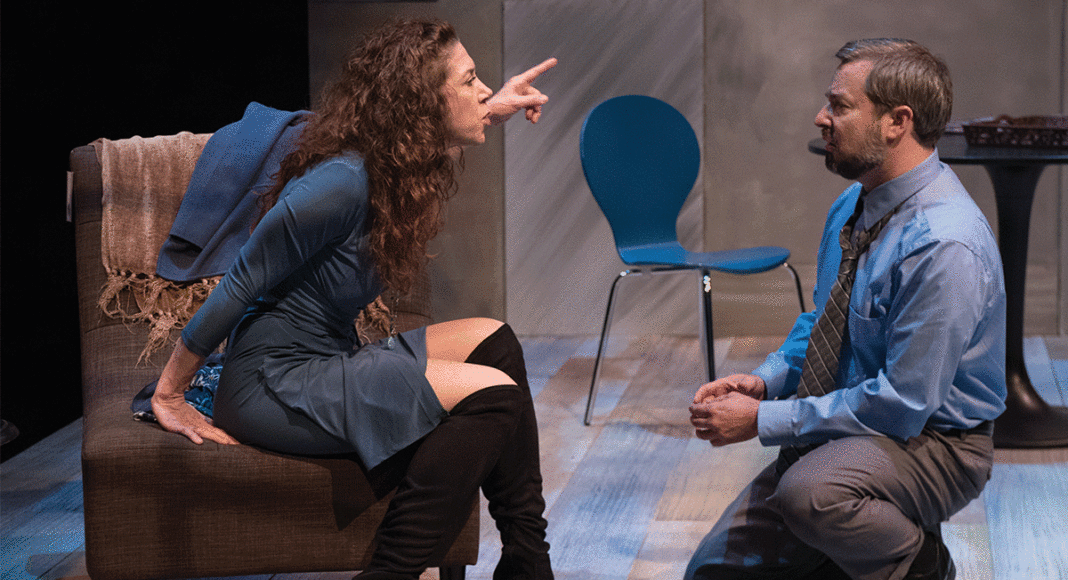It’s so dark and cold in Scandinavia for so much of the year that residents often have to turn to indoor sports. Sniping at each other and dissecting their marriages is one popular recreation, according to The Dance of Death, the classic dysfunctional couple drama from Swedish playwright August Strindberg. Written in the fertile artistic era around the turn of the last century, the venerable play gets a modern update in the new production from Jewel Theatre Company.
Strindberg’s drama was first produced in 1900, at a time when European artists like Klimt and Matisse were deconstructing ideas about what was appropriate to see in art and how to paint it. Nordic playwrights like Strindberg and his contemporary and rival Ibsen were exploring what was appropriate to present onstage—daring to lift the lid on conventional bourgeois society and expose the bitterness and disappointment often seething just below the surface. This new JTC production relocates the story to modern times, working from an updated 2012 English translation of the play from Irish playwright Conor McPherson.
Lifelong military man Edgar (Rolf Saxon) is a captain at an artillery base on a small island in the Stockholm archipelago. A misanthrope who clings to his tiny allotment of power and considers himself a rare “decent” man in a world inhabited by “scum,” he lives with his wife in a tower repurposed from a former military prison.
His wife Alice (Julie James), 15 years his junior, is a former stage actress who gave up her career for marriage. Their two children are grown and gone, and while they are approaching their 25th wedding anniversary, it’s little cause for celebration. Alice feels smothered by a bully who has isolated her from friends and family. (She says she retaliated by doing the same to him.) Edgar contends that her mean temper makes her unhappy.
Accusations and biting sarcasm are their principal means of communication. Edgar’s slippery and random grasp of the truth—he makes up incendiary lies which he later claims not to remember—gives the play an unfortunately timely edge. But Alice and Edgar are forced to confront the disarray of their lives when Alice’s visiting cousin Kurt (Stephen Muterspaugh), who first introduced them, walks into their vipers’ nest.
The vision for this production belongs to director William Peters, who shapes the action with what is ultimately a forgiving fondness for all three characters, despite their nastier moments. He also designed the set: a solid wall of beige, bleached tan, and steel blue with a vague cinder block motif that emphasizes the characters’ isolation. The few sticks of furniture scattered about suggest a midcentury modern vibe, although B. Modern’s costumes are contemporary. (Except for Edgar’s slyly time-warped military coat, with its brass buttons and piping, that he’s evidently been wearing for the last 25 years.)
I especially liked the subtle way Kurt’s suit in the second act coordinates with the colors of the set, while Alice wears a lot of red, a desperate expression of vitality in this sterile environment. And the pale floorboards make a perfect canvas for Mark Hopkins’ evocative lighting design, when patterns of clouds and sunrise reflect through unseen windows.
There are moments when the upgraded text leads to some minor issues. Since a laptop and an iPod figure into the action, the scramble to find a telephone in one key scene seems odd; doesn’t anybody have a cell phone? And once or twice, the action onstage comes to an uneasy halt while a character goes off to one side to change clothes.
But the production looks great, the performances are solid, and Peters dares to conclude the drama on a wistful note of unexpected redemption.
The Jewel Theatre Company production of ‘The Dance of Death’ plays through April 9 at the Colligan Theater at The Tannery. For tickets, call 425-7506 or visit jeweltheater.net.














